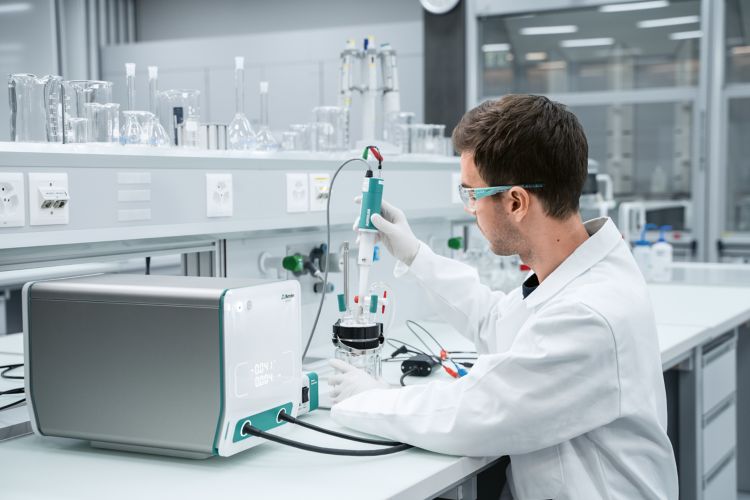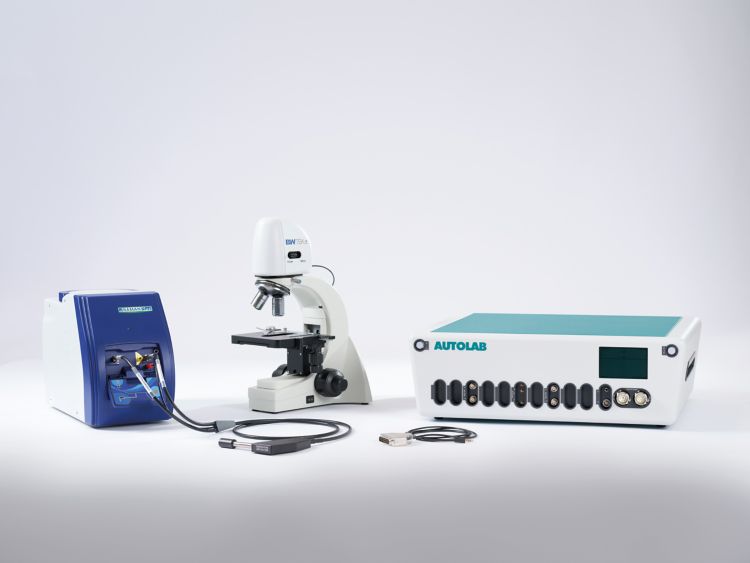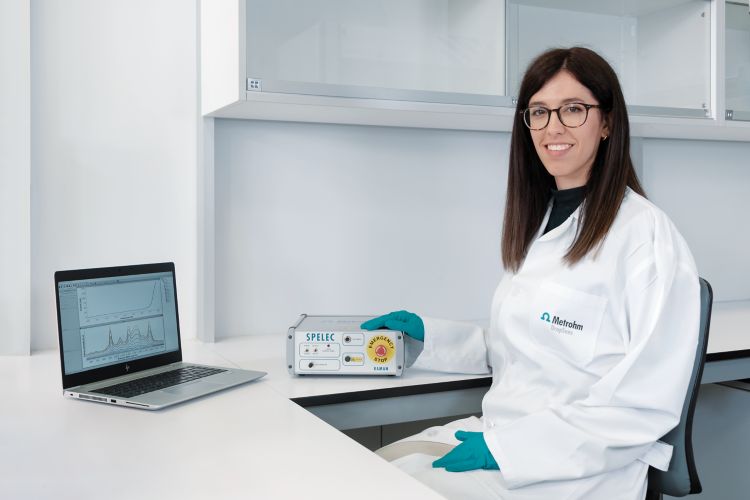Whatever your requirements – we have the right potentiostat and galvanostat for you
Our portfolio of electrochemical measuring instruments includes compact to modular and single-channel to multi-channel potentiostats and galvanostats. Use the filters to refine your search and find the perfect instrument for you.
Why Metrohm potentiostats? – We are the global market leader

Metrohm sets the standard for electrochemistry instrumentation. Over 30 years ago, we pioneered the first commercially available digital potentiostat/galvanostat under complete computer control. Our dedication to innovation continues to drive us forward. Today, we provide a wide range of electrochemical instruments, ranging from compact to modular, single-channel to multi-channel and benchtop to portable potentiostats and galvanostats.
- Reliability: All our instruments undergo hundreds of quality checks during the manufacturing process. On average, 99% uptime is achieved in the first 5 years of installation.
- Superior service: We offer an industry-leading 3-year warranty for all our instruments, along with local support available in over 120 countries worldwide. This ensures a rapid response for sales and service, usually within 48 hours.

To help our customers get the most out of our instruments, we have created an extensive library of resources, consisting of over 100 application notes, whitepapers, and blog posts. This material covers a wide range of scientific disciplines, such as Electrochemistry, Battery Research, Life Sciences, and Corrosion Studies, among others.
If you are exploring electrochemical techniques such as cyclic voltammetry and Electrochemical Impedance Spectroscopy (EIS), our resources feature practical case studies and related formulas or calculations, providing comprehensive support tailored to your needs.
Potentiostats and galvanostats – FAQs
What is a potentiostat? And what is the difference between a potentiostat and a galvanostat?
A potentiostat is an electrochemical instrument that controls the potential difference (voltage) between the working electrode and the reference electrode while measuring the resulting current flow between the working electrode and the counter electrode (also referred to as auxiliary electrode). The potentiostat maintains a constant potential, allowing for precise control and measurement of electrochemical reactions in corrosion studies, electroplating, battery testing, and sensor development.
A galvanostat, on the other hand, is an electrochemical instrument that controls the cell current rather than the cell voltage.
All Metrohm electrochemical instruments combine both potentiostat and galvanostat into a single device. Users can select the appropriate mode (potentiostatic or galvanostatic) based on the experimental requirements.
Learn more about how a potentiostat works and the role of the electrodes used in electrochemical measurements:
Blog: Fast and fundamental – Influences on reliable electrochemical measurements
Galvanostatic vs. potentiostatic mode
When to choose potentiostatic mode:
- When studying redox reactions, corrosion, electroplating, or any process where maintaining a constant potential is crucial.
- When performing cyclic voltammetry or other techniques that involve sweeping the potential across a range of values.
- When investigating electrochemical behavior, kinetics, and electrode surface properties.
Application note: Potentiostatic intermittent titration technique (PITT)
Application note: ASTM G5 – Potentiodynamic Anodic Polarization Measurements
Application note: Cyclic Potentiodynamic Polarization Measurements as per ASTM G61
When to choose galvanostatic mode:
- When studying electrolysis, electrodeposition, or any process where maintaining a constant current is critical.
- When performing experiments involving fuel cells, batteries, or any electrochemical cell that requires a specific current input.
- When using electrochemical impedance spectroscopy or other techniques that analyze the electrical response of a system.
Application note: Galvanostatic charge-discharge of a Li-ion battery with Autolab
Application note: ASTM G100 – Cyclic Galvanostaircase Polarization
Application note: Galvanostatic Intermittent Titration Technique (GITT)
When to use grounded mode and floating mode in a potentiostat? What is selectable floating?
In a potentiostat, the grounded mode is used when none of the electrodes nor the cell vessel have a direct connection with the ground. This is the most commonly used mode for the vast majority of electrochemical experiments performed in laboratories (i.e., wet electrochemistry research, battery research, corrosion test in lab, etc). If other devices are used during the electrochemical experiments, you can use the faraday cage to ground them.
The floating mode must be used in the following three main cases:
- When the working electrode is directly connected to the Earth ground (grounded WE): Corrosion tests in open air, hydrogen permeation, in-situ electronic microscopy
- When the counter electrode is directly connected to the Earth ground (grounded CE): Bioreactors, autoclave
- When the entire cell is directly connected to the Earth ground (grounded Cell): Tribocorrosion, autoclave
For any of the above-mentioned cases, the correct measurement of the current is only possible if the potentiostat is used with the correct floating mode.
Due to the wide variation of experimental requirements and kinds of electrochemical cells, the use of an electrochemical instrument with a floating feature (such as VIONIC or µStat-i multiX among others) brings additional versatility to the user.
Grounded or floating mode?
How to choose a suitable potentiostat?
Criteria 1: Voltage and current range
Consider the range of potentials and currents you expect to work with.
- Basic requirement: Compliance voltage up to ± 10 V, max. current up to ± 100 mA: PGSTAT101, Autolab IMP, μStat-i 400 – Small, lightweight, and affordable
- Moderate requirement: Compliance voltage ± 20 V, max. current ± 400 mA: PGSTAT204 – Small and able to add one more module (e.g. EIS)
- Advanced requirement: Compliance voltage ± 30 V, max. current ±2 A (upgradeable) : PGSTAT302N – Customizable with a range of modules
- Stringent requirement: Compliance voltage ± 50 V, max. current ± 6 A: VIONIC powered by INTELLO – Highest specification and multi-modules in one instrument
Criteria 2: Is high-throughput or multichannel a need?
If you plan to run multiple experiments simultaneously, you might need a potentiostat with multiple channels.
Criteria 3: Portability
A portable potentiostat can be beneficial in various scenarios where mobility, fieldwork, or on-site measurements are necessary. Metrohm can provide both single-channel and multi-channel portable potentiostats.
Criteria 4: Hyphenated Electrochemistry with third party instruments or Spectroelectrochemistry integrated into one instrument

lf your research requires synchronization of electrochemistry with optical measurements (or other complementary techniques), and you would like to have two independent instruments for electrochemistry and spectroscopy (or the instrument used in the complementary technique) as hyphenated or stand-alone solutions, you can consider our hyphenated solution.
The hyphenated solution includes a UV-Vis or Raman spectroscopy instrument and a Metrohm potentiostat. The Metrohm potentiostats/galvanostats can be purchased separately and used in specific hyphenated setups together with third party instruments. Please contact your local Metrohm support office for further details. With our hyphenated solution, you can enjoy the highest performance and flexibility in both hardware and software selection.
Go to hyphenated spectroelectrochemistry instruments

You can also opt for the integrated product line. All components of spectroelectrochemical devices, i.e., potentiostat, spectrometer, and light source, are integrated in only one instrument with a dedicated software including all specific tools for spectroelectrochemical experiments, such as UV-Vis, NIR and Raman spectroscopy. With the integrated instruments, you benefit from the simplicity of the hardware set up and of working with a single software.
